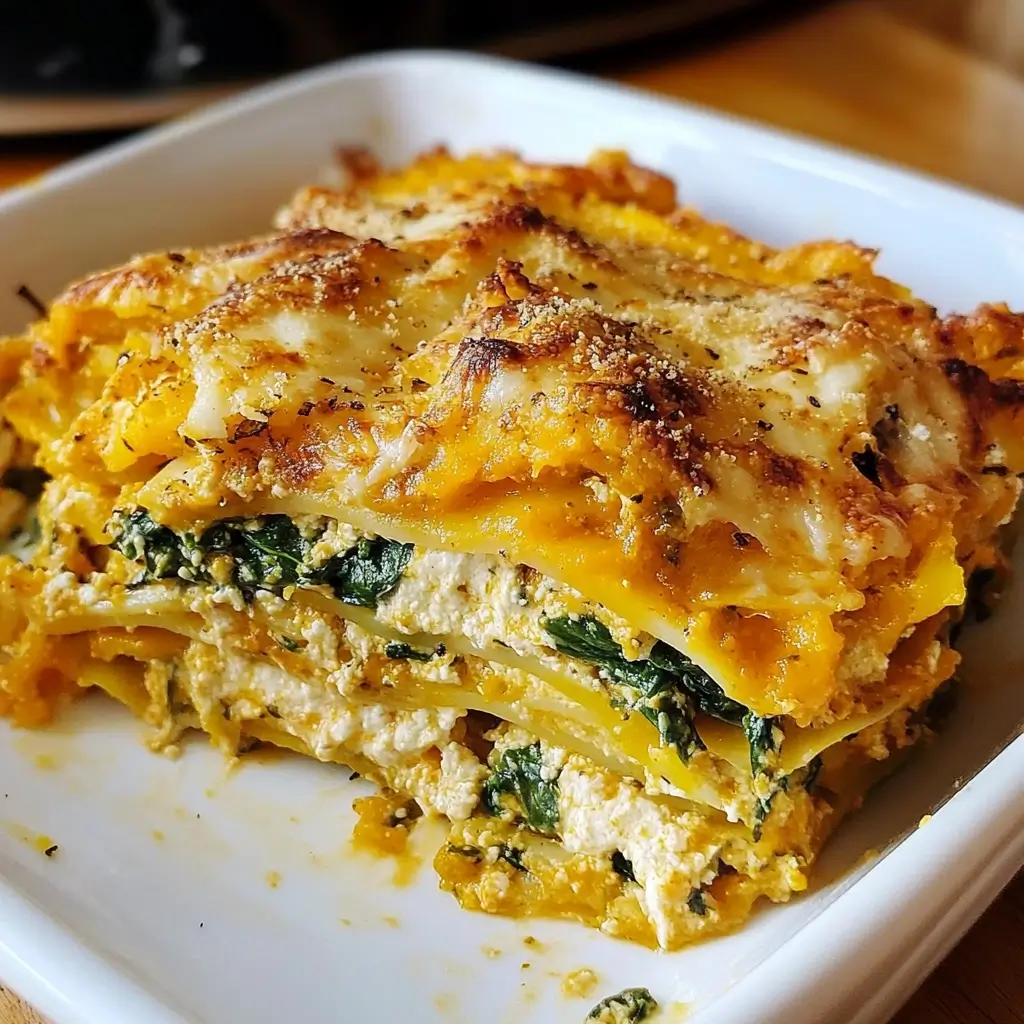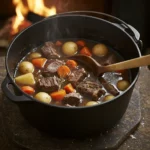Lasagna night used to be a strictly meat-sauce affair in our household. Ground beef, rich tomato sauce, and layers of cheesy goodness – a classic for a reason, but perhaps a bit… heavy. Then came the day I decided to experiment, craving something lighter yet equally satisfying. Enter the Butternut Squash and Spinach Lasagna. Initially met with a touch of skepticism (my family are creatures of habit!), this vegetarian marvel quickly won everyone over. The creamy sweetness of roasted butternut squash, the earthy notes of spinach, and the comforting layers of pasta, ricotta, and béchamel sauce created a symphony of flavors and textures that was both familiar and excitingly new. Even my most ardent meat-lover declared it a “lasagna game-changer!” Now, it’s a regular request, particularly during the cozy fall and winter months. It’s a dish that proves vegetarian comfort food can be just as indulgent and heartwarming as its meaty counterparts, and this recipe? It’s become our absolute go-to.
Ingredients: The Building Blocks of Flavor
To create this delectable Butternut Squash and Spinach Lasagna, you’ll need a selection of fresh, quality ingredients. Let’s break down each component to ensure you have everything you need for lasagna success.
For the Butternut Squash:
- 1 large butternut squash (about 3 pounds): Choose a squash that feels heavy for its size, with a firm neck and no soft spots. The vibrant orange flesh is key to the dish’s sweetness and color.
- 2 tablespoons olive oil: Extra virgin olive oil is preferred for its flavor and health benefits, but regular olive oil will also work.
- 1 teaspoon dried sage: Sage perfectly complements butternut squash, adding an earthy and slightly peppery note. Fresh sage can also be used – about 1 tablespoon chopped.
- ½ teaspoon salt: Enhances the natural sweetness of the squash.
- ¼ teaspoon black pepper: Adds a touch of spice to balance the sweetness.
For the Spinach Filling:
- 1 tablespoon olive oil: For sautéing the aromatics and spinach.
- 1 medium onion, finely chopped: Yellow or white onion works well, providing a savory base.
- 2 cloves garlic, minced: Freshly minced garlic is essential for its pungent aroma and flavor.
- 10 ounces fresh spinach, roughly chopped: Baby spinach is convenient, but regular spinach is also suitable – just ensure it’s well washed and stems are removed.
- ½ teaspoon salt: To season the spinach and bring out its flavor.
- ¼ teaspoon black pepper: For a touch of spice.
- Pinch of nutmeg: Nutmeg adds a warm, subtle spice that beautifully complements spinach and creamy sauces.
For the Béchamel Sauce (White Sauce):
- 4 tablespoons unsalted butter: Butter forms the base of the roux and adds richness to the sauce.
- 4 tablespoons all-purpose flour: Used to thicken the sauce. Gluten-free all-purpose blends can be substituted.
- 4 cups milk: Whole milk creates the richest sauce, but 2% milk can also be used. For a lighter option, try unsweetened almond milk or oat milk, though the sauce will be less creamy.
- ½ teaspoon salt: To season the béchamel.
- ¼ teaspoon white pepper: White pepper is traditionally used in béchamel for a milder pepper flavor and to keep the sauce visually white, but black pepper can be substituted.
- Pinch of nutmeg: A touch of nutmeg enhances the warmth of the béchamel.
For the Ricotta Cheese Mixture:
- 15 ounces ricotta cheese (whole milk or part-skim): Ricotta provides creamy texture and a tangy counterpoint to the sweet squash and rich béchamel.
- ½ cup grated Parmesan cheese: Adds salty, savory, and umami notes. Pecorino Romano can also be used for a sharper flavor.
- 1 large egg, lightly beaten: Helps bind the ricotta mixture together.
- ¼ cup chopped fresh parsley: Parsley adds freshness and a pop of color. Fresh basil or chives could also be used.
- ½ teaspoon salt: To season the ricotta mixture.
- ¼ teaspoon black pepper: For a touch of spice.
Other Essentials:
- 9-12 lasagna noodles (oven-ready or regular): Oven-ready noodles simplify the process, but regular lasagna noodles work just as well – just remember to pre-cook them according to package directions. Use gluten-free lasagna noodles if needed.
- 1 cup shredded mozzarella cheese: Mozzarella provides that classic cheesy melt and stretch that is essential for lasagna.
- ¼ cup grated Parmesan cheese (for topping): For extra cheesy flavor and browning on top.
Instructions: Step-by-Step to Lasagna Perfection
Follow these detailed instructions to assemble your Butternut Squash and Spinach Lasagna. Breaking it down into steps makes it manageable and ensures success.
Step 1: Roast the Butternut Squash
- Preheat oven to 400°F (200°C). Line a baking sheet with parchment paper for easy cleanup.
- Prepare the squash: Carefully peel the butternut squash using a sharp vegetable peeler. Cut the squash in half lengthwise and scoop out the seeds and stringy pulp. Cut the squash into 1-inch cubes.
- Season and roast: In a large bowl, toss the cubed butternut squash with 2 tablespoons of olive oil, 1 teaspoon dried sage, ½ teaspoon salt, and ¼ teaspoon black pepper. Spread the squash in a single layer on the prepared baking sheet.
- Roast for 25-30 minutes, or until the squash is tender and slightly caramelized. Stir halfway through to ensure even roasting.
- Set aside to cool slightly. Once cooled, you can mash a portion of the squash with a fork for a smoother texture in the lasagna, if desired (optional).
Step 2: Prepare the Spinach Filling
- Sauté aromatics: Heat 1 tablespoon of olive oil in a large skillet over medium heat. Add the chopped onion and cook until softened, about 5 minutes. Add the minced garlic and cook for another minute until fragrant, being careful not to burn it.
- Wilt the spinach: Add the roughly chopped spinach to the skillet in batches. Cook, stirring occasionally, until the spinach wilts down significantly. This will take just a few minutes.
- Season and drain (optional): Season the spinach mixture with ½ teaspoon salt, ¼ teaspoon black pepper, and a pinch of nutmeg. If there is excess liquid in the skillet, you can drain it off or continue cooking until it evaporates – you don’t want watery lasagna.
- Set aside.
Step 3: Make the Béchamel Sauce
- Melt butter: In a medium saucepan over medium heat, melt the 4 tablespoons of unsalted butter.
- Make the roux: Add the 4 tablespoons of all-purpose flour to the melted butter. Whisk constantly for 1-2 minutes until the mixture is smooth and slightly golden. This is your roux.
- Whisk in milk gradually: Slowly pour in the 4 cups of milk, whisking continuously to prevent lumps from forming. Continue whisking until the sauce starts to thicken and come to a gentle simmer.
- Simmer and season: Reduce the heat to low and simmer for 5-7 minutes, stirring occasionally, until the béchamel sauce has thickened to a smooth, creamy consistency that coats the back of a spoon.
- Season: Remove from heat and season with ½ teaspoon salt, ¼ teaspoon white pepper (or black pepper), and a pinch of nutmeg. Taste and adjust seasonings as needed.
Step 4: Prepare the Ricotta Mixture
- Combine ingredients: In a medium bowl, combine the 15 ounces of ricotta cheese, ½ cup grated Parmesan cheese, 1 lightly beaten egg, ¼ cup chopped fresh parsley, ½ teaspoon salt, and ¼ teaspoon black pepper.
- Mix well: Stir until all ingredients are well combined.
Step 5: Assemble the Lasagna
- Preheat oven to 375°F (190°C). Lightly grease a 9×13 inch baking dish.
- Layer the lasagna:
- Bottom layer: Spread a thin layer of béchamel sauce (about ½ cup) over the bottom of the baking dish.
- Noodles: Arrange a layer of lasagna noodles over the béchamel sauce, slightly overlapping if necessary.
- Ricotta mixture: Spread half of the ricotta cheese mixture evenly over the noodles.
- Spinach filling: Spread half of the spinach filling evenly over the ricotta.
- Butternut squash: Distribute half of the roasted butternut squash cubes evenly over the spinach.
- Mozzarella: Sprinkle about ⅓ cup of shredded mozzarella cheese over the squash.
- Béchamel sauce: Drizzle about ½ cup of béchamel sauce over the mozzarella.
- Repeat layers: Repeat layers of noodles, ricotta mixture, spinach filling, butternut squash, mozzarella, and béchamel sauce.
- Top layer: For the final layer, top with lasagna noodles, remaining béchamel sauce, remaining mozzarella cheese, and sprinkle with ¼ cup grated Parmesan cheese.
Step 6: Bake the Lasagna
- Cover and bake: Cover the baking dish tightly with aluminum foil.
- Bake for 30 minutes.
- Uncover and bake: Remove the foil and bake for another 20-25 minutes, or until the lasagna is bubbly, the cheese is melted and golden brown, and the noodles are tender when pierced with a fork.
- Rest: Let the lasagna rest for 10-15 minutes before slicing and serving. This allows the lasagna to set and makes it easier to cut.
Nutrition Facts: A Wholesome and Satisfying Meal
- Servings: 9-12 servings (depending on slice size)
- Calories per serving (estimated, per serving of 1/9th of lasagna): Approximately 450-550 calories (This is an estimate and can vary based on specific ingredient brands and portion sizes. For precise nutritional information, use a nutrition calculator with the exact ingredients used.)
Approximate Nutritional Breakdown per Serving (estimated):
- Protein: 20-25g
- Fat: 25-30g
- Carbohydrates: 40-50g
- Fiber: 5-7g
This Butternut Squash and Spinach Lasagna is a good source of protein, fiber, and vitamins from the vegetables and dairy. It offers a balanced meal that is both satisfying and relatively wholesome compared to traditional meat-heavy lasagnas.
Preparation Time: Plan Ahead for Deliciousness
- Prep time: Approximately 45-60 minutes (includes roasting squash, making sauces, and preparing fillings)
- Cook time: Approximately 50-55 minutes
- Total time: Approximately 1 hour 35 minutes – 1 hour 55 minutes (plus resting time)
While lasagna takes a bit of time to prepare, much of it is hands-off. Roasting the squash and simmering the béchamel can be done simultaneously, and the assembly process is quite straightforward once all components are ready. This lasagna is perfect for weekend cooking or when you have a bit more time to dedicate to a truly rewarding meal.
How to Serve: Complementing Your Lasagna
This Butternut Squash and Spinach Lasagna is a complete meal in itself, but you can enhance the dining experience with some well-chosen side dishes.
- Classic Salad:
- A simple green salad with a light vinaigrette dressing provides a refreshing contrast to the richness of the lasagna.
- Consider adding seasonal greens, cherry tomatoes, cucumbers, and a sprinkle of toasted nuts for texture.
- Garlic Bread or Crusty Bread:
- Warm garlic bread or crusty Italian bread is perfect for soaking up any extra béchamel sauce and complementing the flavors of the lasagna.
- Brush slices of baguette with garlic butter and toast in the oven for a quick and easy side.
- Roasted Vegetables:
- If you want to add even more vegetables to your meal, consider serving roasted asparagus, broccoli, or Brussels sprouts alongside the lasagna.
- Roast them simply with olive oil, salt, and pepper to maintain a healthy and flavorful side.
- Wine Pairing:
- A light-bodied red wine like Pinot Noir or a medium-bodied white wine like Chardonnay pairs well with the creamy and savory flavors of this lasagna.
- For a non-alcoholic option, sparkling cider or a crisp Italian soda would be refreshing.
Additional Tips for Lasagna Success
Here are five helpful tips to elevate your Butternut Squash and Spinach Lasagna to the next level:
- Tip 1: Roast Squash in Advance: Roasting the butternut squash can be done a day or two ahead of time. Store the roasted squash in an airtight container in the refrigerator. This breaks up the prep time and makes assembly quicker on the day you plan to bake the lasagna.
- Tip 2: Make-Ahead Béchamel: The béchamel sauce can also be prepared in advance. Once cooked, place plastic wrap directly on the surface of the sauce to prevent a skin from forming and refrigerate for up to 2 days. Reheat gently over low heat, whisking occasionally, until smooth before using.
- Tip 3: Use Oven-Ready Noodles for Convenience: Oven-ready lasagna noodles are a fantastic time-saver. They eliminate the need for pre-boiling, making the assembly process much faster and easier. Just be sure to use enough sauce to properly hydrate them during baking.
- Tip 4: Customize with Cheese: Feel free to experiment with different cheeses. Fontina, Gruyere, or provolone can be added to the mozzarella for a more complex cheese flavor. For a sharper flavor, use Pecorino Romano instead of Parmesan.
- Tip 5: Add a Layer of Pesto: For an extra layer of flavor, consider spreading a thin layer of pesto (basil pesto or even a sun-dried tomato pesto) between the ricotta and spinach layers. This adds a vibrant herbaceous note and complements the other flavors beautifully.
FAQ Section: Your Lasagna Questions Answered
Q1: Can I use frozen spinach instead of fresh spinach?
A: Yes, you can use frozen spinach. Thaw the frozen spinach completely and squeeze out as much excess water as possible before sautéing it. About 10 ounces of frozen spinach (thawed and drained) is equivalent to 10 ounces of fresh spinach.
Q2: Can I make this lasagna gluten-free?
A: Absolutely! Simply use gluten-free lasagna noodles and ensure your béchamel sauce is made with a gluten-free all-purpose flour blend or cornstarch as a thickener. All other ingredients in the recipe are naturally gluten-free.
Q3: Can I freeze this lasagna?
A: Yes, this Butternut Squash and Spinach Lasagna freezes beautifully. Assemble the lasagna in a freezer-safe dish, but do not bake it. Wrap it tightly with plastic wrap and then aluminum foil. Freeze for up to 3 months. To bake from frozen, thaw overnight in the refrigerator, or bake directly from frozen (covered) at 350°F (175°C) for about 1 hour 30 minutes to 2 hours, or until heated through and bubbly. Uncover for the last 20-30 minutes to brown the cheese.
Q4: I don’t have butternut squash; can I substitute another vegetable?
A: Yes, you can substitute other winter squashes like acorn squash or kabocha squash. Sweet potatoes would also be a delicious alternative, offering a similar sweetness and creamy texture when roasted.
Q5: What if I don’t have ricotta cheese? Can I use something else?
A: While ricotta is traditional, you can substitute it with cottage cheese that has been well-drained and blended until smooth. Crème fraîche or mascarpone cheese could also work for a richer, creamier alternative, although they will alter the overall flavor profile slightly.
This Butternut Squash and Spinach Lasagna is more than just a vegetarian dish; it’s a celebration of flavors and textures that will delight everyone at your table. Enjoy the process of creating this comforting and satisfying meal, and savor every delicious bite!
Print
Butternut Squash and Spinach Lasagna Recipe
Ingredients
For the Butternut Squash:
- 1 large butternut squash (about 3 pounds): Choose a squash that feels heavy for its size, with a firm neck and no soft spots. The vibrant orange flesh is key to the dish’s sweetness and color.
- 2 tablespoons olive oil: Extra virgin olive oil is preferred for its flavor and health benefits, but regular olive oil will also work.
- 1 teaspoon dried sage: Sage perfectly complements butternut squash, adding an earthy and slightly peppery note. Fresh sage can also be used – about 1 tablespoon chopped.
- ½ teaspoon salt: Enhances the natural sweetness of the squash.
- ¼ teaspoon black pepper: Adds a touch of spice to balance the sweetness.
For the Spinach Filling:
- 1 tablespoon olive oil: For sautéing the aromatics and spinach.
- 1 medium onion, finely chopped: Yellow or white onion works well, providing a savory base.
- 2 cloves garlic, minced: Freshly minced garlic is essential for its pungent aroma and flavor.
- 10 ounces fresh spinach, roughly chopped: Baby spinach is convenient, but regular spinach is also suitable – just ensure it’s well washed and stems are removed.
- ½ teaspoon salt: To season the spinach and bring out its flavor.
- ¼ teaspoon black pepper: For a touch of spice.
- Pinch of nutmeg: Nutmeg adds a warm, subtle spice that beautifully complements spinach and creamy sauces.
For the Béchamel Sauce (White Sauce):
- 4 tablespoons unsalted butter: Butter forms the base of the roux and adds richness to the sauce.
- 4 tablespoons all-purpose flour: Used to thicken the sauce. Gluten-free all-purpose blends can be substituted.
- 4 cups milk: Whole milk creates the richest sauce, but 2% milk can also be used. For a lighter option, try unsweetened almond milk or oat milk, though the sauce will be less creamy.
- ½ teaspoon salt: To season the béchamel.
- ¼ teaspoon white pepper: White pepper is traditionally used in béchamel for a milder pepper flavor and to keep the sauce visually white, but black pepper can be substituted.
- Pinch of nutmeg: A touch of nutmeg enhances the warmth of the béchamel.
For the Ricotta Cheese Mixture:
- 15 ounces ricotta cheese (whole milk or part-skim): Ricotta provides creamy texture and a tangy counterpoint to the sweet squash and rich béchamel.
- ½ cup grated Parmesan cheese: Adds salty, savory, and umami notes. Pecorino Romano can also be used for a sharper flavor.
- 1 large egg, lightly beaten: Helps bind the ricotta mixture together.
- ¼ cup chopped fresh parsley: Parsley adds freshness and a pop of color. Fresh basil or chives could also be used.
- ½ teaspoon salt: To season the ricotta mixture.
- ¼ teaspoon black pepper: For a touch of spice.
Instructions
Step 1: Roast the Butternut Squash
- Preheat oven to 400°F (200°C). Line a baking sheet with parchment paper for easy cleanup.
- Prepare the squash: Carefully peel the butternut squash using a sharp vegetable peeler. Cut the squash in half lengthwise and scoop out the seeds and stringy pulp. Cut the squash into 1-inch cubes.
- Season and roast: In a large bowl, toss the cubed butternut squash with 2 tablespoons of olive oil, 1 teaspoon dried sage, ½ teaspoon salt, and ¼ teaspoon black pepper. Spread the squash in a single layer on the prepared baking sheet.
- Roast for 25-30 minutes, or until the squash is tender and slightly caramelized. Stir halfway through to ensure even roasting.
- Set aside to cool slightly. Once cooled, you can mash a portion of the squash with a fork for a smoother texture in the lasagna, if desired (optional).
Step 2: Prepare the Spinach Filling
- Sauté aromatics: Heat 1 tablespoon of olive oil in a large skillet over medium heat. Add the chopped onion and cook until softened, about 5 minutes. Add the minced garlic and cook for another minute until fragrant, being careful not to burn it.
- Wilt the spinach: Add the roughly chopped spinach to the skillet in batches. Cook, stirring occasionally, until the spinach wilts down significantly. This will take just a few minutes.
- Season and drain (optional): Season the spinach mixture with ½ teaspoon salt, ¼ teaspoon black pepper, and a pinch of nutmeg. If there is excess liquid in the skillet, you can drain it off or continue cooking until it evaporates – you don’t want watery lasagna.
- Set aside.
Step 3: Make the Béchamel Sauce
- Melt butter: In a medium saucepan over medium heat, melt the 4 tablespoons of unsalted butter.
- Make the roux: Add the 4 tablespoons of all-purpose flour to the melted butter. Whisk constantly for 1-2 minutes until the mixture is smooth and slightly golden. This is your roux.
- Whisk in milk gradually: Slowly pour in the 4 cups of milk, whisking continuously to prevent lumps from forming. Continue whisking until the sauce starts to thicken and come to a gentle simmer.
- Simmer and season: Reduce the heat to low and simmer for 5-7 minutes, stirring occasionally, until the béchamel sauce has thickened to a smooth, creamy consistency that coats the back of a spoon.
- Season: Remove from heat and season with ½ teaspoon salt, ¼ teaspoon white pepper (or black pepper), and a pinch of nutmeg. Taste and adjust seasonings as needed.
Step 4: Prepare the Ricotta Mixture
- Combine ingredients: In a medium bowl, combine the 15 ounces of ricotta cheese, ½ cup grated Parmesan cheese, 1 lightly beaten egg, ¼ cup chopped fresh parsley, ½ teaspoon salt, and ¼ teaspoon black pepper.
- Mix well: Stir until all ingredients are well combined.
Step 5: Assemble the Lasagna
- Preheat oven to 375°F (190°C). Lightly grease a 9×13 inch baking dish.
- Layer the lasagna:
- Bottom layer: Spread a thin layer of béchamel sauce (about ½ cup) over the bottom of the baking dish.
- Noodles: Arrange a layer of lasagna noodles over the béchamel sauce, slightly overlapping if necessary.
- Ricotta mixture: Spread half of the ricotta cheese mixture evenly over the noodles.
- Spinach filling: Spread half of the spinach filling evenly over the ricotta.
- Butternut squash: Distribute half of the roasted butternut squash cubes evenly over the spinach.
- Mozzarella: Sprinkle about ⅓ cup of shredded mozzarella cheese over the squash.
- Béchamel sauce: Drizzle about ½ cup of béchamel sauce over the mozzarella.
- Repeat layers: Repeat layers of noodles, ricotta mixture, spinach filling, butternut squash, mozzarella, and béchamel sauce.
- Top layer: For the final layer, top with lasagna noodles, remaining béchamel sauce, remaining mozzarella cheese, and sprinkle with ¼ cup grated Parmesan cheese.
Step 6: Bake the Lasagna
- Cover and bake: Cover the baking dish tightly with aluminum foil.
- Bake for 30 minutes.
- Uncover and bake: Remove the foil and bake for another 20-25 minutes, or until the lasagna is bubbly, the cheese is melted and golden brown, and the noodles are tender when pierced with a fork.
- Rest: Let the lasagna rest for 10-15 minutes before slicing and serving. This allows the lasagna to set and makes it easier to cut.
Nutrition
- Serving Size: One Normal Portion
- Calories: 450-550
- Fat: 25-30g
- Carbohydrates: 40-50g
- Fiber: 5-7g
- Protein: 20-25g




